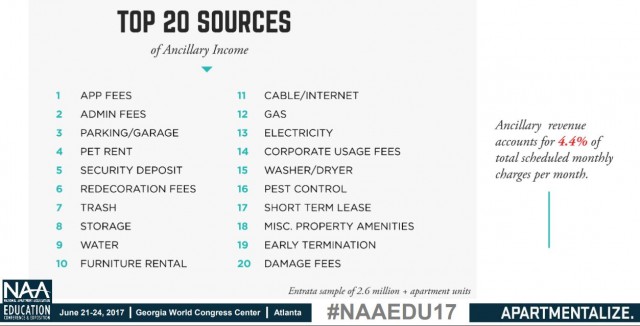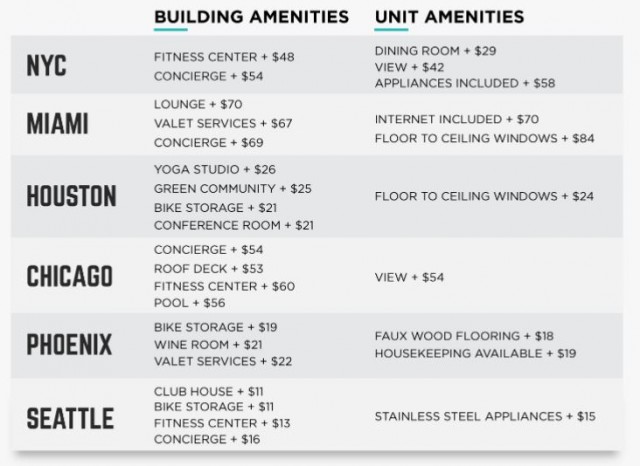Multifamily Blogs
What are the Top Sources of Ancillary Income?
What are the Top Sources of Ancillary Income?
Ancillary income for multifamily properties is always a hot topic, both for punitive fee-based charges, as well as service upgrades, and was a compelling session topic at the 2017 National Apartment Association Education Conference and Expo. According to Chase Harrington, COO of Entrata, ancillary income averages 4.4% of scheduled monthly charges, and he shared their research on the top 20 sources of ancillary income:
Additionally, the panelists at the session, Gunti Weissenberger of Westover Companies, Kellie Hughes of Mill Creek, and Robert Speck of Bonaventure, shared their top 10 sources of ancillary income:
|
Westover Companies |
Mill Creek (Modera Brand) |
Mill Creek (Alister Brand) |
Bonaventure |
|
Utilities |
Garage |
Early Termination Fees |
Late Fee Income |
|
Early Termination Fees |
Parking |
Parking |
Garage Income |
|
Laundry |
Early Termination Fees |
Laundry Income |
Bldg Facility (Renters Insurance) |
|
Month to Month Fee |
Amenity Fee |
Late Fee |
Pet Rent |
|
Pet Income |
Storage |
Pet Premium |
Month to Month Premium |
|
Water |
Application Fee |
Administration Fee |
Laundry Income |
|
Billing Fee |
Pet Premium |
Application Fee |
Valet Trash |
|
Cable Internet |
Initial Pet Fee |
Initial Pet Fee |
Application Fees |
|
Late Fee |
Administration Fee |
Misc Income |
Pet Move-In Fee |
|
Short Term Premium |
Late Fee |
Storage |
Parking Income |
The session also shared some data from NAA on actual ancillary income averages in some top metro areas:
The panelists also shared some insightful comments about specific ancillary income options:
RUBS - Gunti Weissenberger indicated that they don't prefer using RUBS as their residents don't like the way utilities are broken out. He mentioned that when they switch to submetering, they lower rent to mitigate resident complaints, and then make plans to raise rents upon renewal or with new residents.
Fees Versus Upgrades - Kellie Hughes mentioned that their two brands were distinct in the types of ancillary income they maximized based upon the class of assets for each brand. Their high end brand focused on upgrades that residents opted into paying for, while their other brand's ancillary income derived more from punitive, fee-based income from late charges and the like.
Renter's Insurance Lapses - Having renters insurance lapse is a challenging problem, so Mill Creek charges a $50/month fee if the resident lets their renters insurance lapse until they get it reinstated.
Common Area Maintenance? Kellie indicated that in some markets, it is common to charge a "Common Area Maintenance" fee, intended to provide cleaning services for hallways. In an off-the-cuff polling of some on the Insiders community, we didn't find much use, or even knowledge, of this fee, but maybe this will expand to other markets in the future?
Real Estate Taxes Fee? Gunti mentioned that oftentimes, real estate tax increases for multifamily properties are done without much consideration from multifamily owners. So they are considering a fee to pass along those tax increases in order to have their residents have a vested interest in any potential increase. The idea is that the residents would join in any push against a rise in real estate taxes.
Unit Upgrade Income - Robert shared how Bonaventure will provide upgrades to a unit (if they are in line with the existing design of the apartment) for a charge to that resident. Once that resident ultimately moves out, they then charge subsequent residents for that upgrade, as those upgrades remain with the apartment.
Are these ancillary income averages in line with what your company is charging? Any other strategies that your company is utilizing to increase ancillary income?



